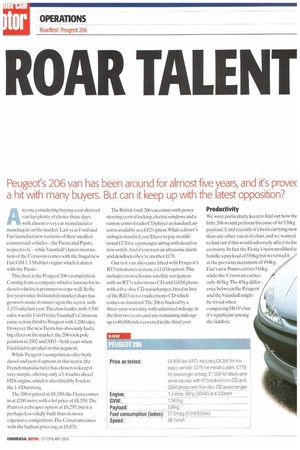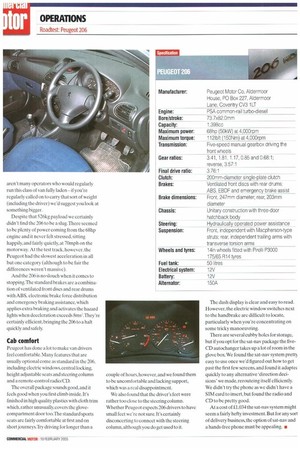ROAR TALENT
Page 40

Page 41

Page 42

If you've noticed an error in this article please click here to report it so we can fix it.
Peugeot's 206 van has been around for almost five years, and it's prove( a hit with many buyers. But can it keep up with the latest opposition?
Anyonc considering buying a car-derived van has plenty of choice these days, with almost every car manufacturer muscling in on the market. Last year Ford and Fiat launched new versions of their smallest commercial vehicles— the Fiesta and Punto, respectively — while Vauxhall's latest incarnation of the Corsavan comes with the frugal new Fiat/GM 1.3 Multijet engine which it shares with the Punto.
This then.is the Peugeot 206's competition. Coming from a company which is famous for its diesel vehicles, it promises to cope well, in the five years since its launch its market share has grown to make it runner-up in the sector,with 1,335 sales last year.The class leader, with 3.500 sales, was the Ford Fiesta; Vauxhall's Corsavan came a close third to Peugeot with 1200 sales. However, the new Fiesta has obviously had a big effect on the market: the 206 took pole position in 2002 and 2003 — both years when Ford had no product in this segment.
While Peugeot's competition offer both diesel and petrol options in this sector, the French manufacturer has chosen to keep it very simple, offering only a 1.4 turbo-diesel HDi engine, which is also fitted by Ford as the 1.4 Duratorq.
The 206 is priced at £8,350; the Fiesta comes in ati200 more with a list price of £8,550,The Punto is a cheaper option at £8,295, but it is perhaps less solidly built than its more expensive competitors The Corsavan comes with the highest price tag, at £8,870. The British-built 206 van comes with power steering,central locking, electric windows and a remote control radio/CD player as standard; aircon is available as a425 option. While a driver's airbag is standard, you'll have to pay an additional1178 for a passenger airbag with deactivation switch And if you want an ultrasonic alarm and deadlocks they're another £170.
Our test van also came fitted with Peugeot's RT3 telernatics system:a £1,034 option. This includes monochrome satellite navigation with an RT3 radio/mono CD and GSM phone with a five-disc CD autochanger, fitted in lieu of the RD3 stereo radio/mono CD which comes as standard.The 206 is backed by a three-year warranty, with unlimited mileage in the first two years, and any remaining mileage up to 60,000 miles covered in the third year.
Productivity
We were particularly keen to find out how the little 206 would perform because of its 526kg payload. Until recently it's been carrying mor than any other van in its class, and we wanted to find out if this would adversely affect its fue economy. In fact the Fiesta's been modified tc handle a payload of 558kg but we tested it at the previous maximum of 494kg. Fiat's new Punto carries 510kg, while the Corsavan carries only 465kg.The 45kg difference between the Peugeot and the Vauxhall might be trivial when comparing HGVs but it's significant among the tiddlers. So it was with some trepidation that we set off fully laden round our Kent route. Would the extra payload really hammer fuel economy? As it turns out, there is a difference, but it's far smaller than we had feared. Fully laden, the Peugeot managed to achieve 57mpg, which is hard on the heels of both the Ford Fiesta (58mpg) and the Vauxhall Corsavan (57.7mpg).
Only the frugal Fiat Punto managed to outperform it. and them, squeezing an impressive 51.4mpg out of its 1.3 Multijet engine despite that 510kg payload.
Running urladen the Peugeot achieved 50.2mpg, which was actually the poorest unladen performance of the four vans we're z,omparing,but only by a small margi The Corsavan managed 52.1mpg, the Fiesta matched it with 62.2mpg, while the Punto once again claimed the consumption crown with a thrifty 64.1mpg.
On the road Peugeot has earned a reputation for producing diesel vehicles which drive well, so we expected a lot from the 206. Running empty we weren't disappointed: crisp, precise handling made driving round the winding Surrey lanes less challenging than in some other vehicles we've driven. Definitely a pleasurable experience, with the gears being smooth and easy to use and the whole set-up providing a competent and stable ride.
Load it up to the 526kg limit, however, and it's a different story. For starters, even though we had tried to distribute the load pretty evenly (to the extent of carrying sand-filled test weights on the front seat beside us), we found the poor Peugeot was way down at the back,making attempts to see out of the back window more of a challenge than usual.
Perhaps it's just a question of contrast. You go f om feeling like you have all the precision ha dling of a rally car to something that's a bit v gue and far less fun to drive. Of course there aren't many operators who would regularly run this class of van fully laden —if you're regularly called on to carry that sort of weight (including the driver) we'd suggest you look at something bigger.
Despite that 526kg payload we certainly didn't find the 206 to be a slug.There seemed to be plenty of power coming from the 68hp engine and it never felt stressed, sitting happily, and fairly quietly, at 70mph on the motorway. At the test track, however, the Peugeot had the slowest acceleration in all but one category (although to be fair the differences weren't massive).
And the 206 is no slouch when it comes to stopping.The standard brakes are a combination of ventilated front discs and rear drums with ABS, electronic brake force distribution and emergency braking assistance, which applies extra braking and activates the hazard lights when deceleration exceeds ms. They're certainly efficient, bringing the 206 to a halt quickly and safely.
Cab comfort
Peugeot has done a lot to make van drivers feel comfortable. Many features that are usually optional come as standard in the 206, including electric windows, central locking, height adjustable seats and steering column and a remote-control radio/CD.
The overall package sounds good, and it feels good when you first climb inside. It's finished in high quality plastics with cloth trim which,rather unusually, covers the glovecompartment door too.The standard sports seats are fairly comfortable at first and on short journeys.Try driving for longer than a couple of hours, however, and we found them to be uncomfortable and lacking support, which was a real disappointment.
We also found that the driver's feet were rather too close to the steering column. Whether Peugeot expects 206 drivers to have small feet we're not sure. It's certainly disconcerting to connect with the steering column, although you do get used to it. The dash display is clear and easy to read. However, the electric window switches next to the handbrake are difficult to locate, particularly when you're concentrating on some tricky manoeuvring.
There are several cubby holes for storage, but if you opt for the sat-nay package the fiveCD autochanger takes up a lot of room in the glove box.We found the sat-nay system pretty easy to use once we'd figured out how to get past the first few screens, and found it adaptec quickly to any alternative 'direction decisions' we made, rerouteing itself efficiently. We didn't try the phone as we didn't have a SIM card to insert, but found the radio and CD to be pretty good.
At a cost of £1.034 the sat-nay system might seem a fairly hefty investment. But for any sort of delivery business, the option of sat-nay and a hands-free phone must be appealing. m






































































































































































































